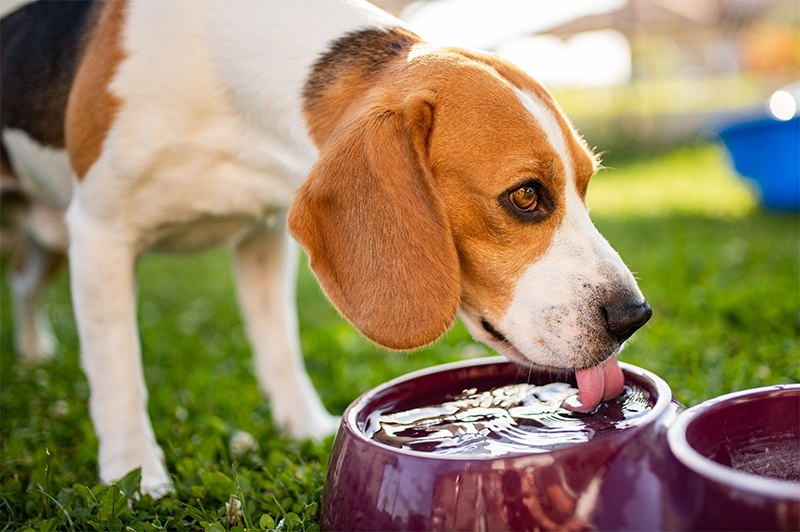Help Your Pet Avoid Dehydration This Summer

Water is the most abundant nutrient in your pet’s body, making up 75-80 percent of their composition. Water transports vital nutrients and removes waste. With the critical nature of its function, it’s essential your pet takes in the water they need.
In the summer months we often burn excessive amounts of water in the heat. If it is not replaced, dehydration occurs. For our pets, dehydration can occur more quickly because they get hot faster and do not sweat. Being aware of the threat of dehydration and how your pet responds to it can help you avoid it.
Signs of Dehydration
We can recognize our own dehydration as a dry mouth, water craving, headaches, and irritability. Even though your pet won’t ask for a glass of cold water when they’re hot, they will exhibit behaviors that can help you know when you need to step in. It’s important to look for and recognize these signs early to avoid life threatening complications.
Here are some signs your pet might need your help to cool down and rehydrate:
- Lethargy – Pet has lost their appetite, is moving slower, panting heavily, has an increased heart rate or even a weak pulse.
- Dry mouth (xerostomia) – Gums do not feel moist to the touch but are dry and sticky
- Sunken eyes, Shock, and Collapse – Signs of severe dehydration
Remember, dehydration can occur indoors, too. If the temperature gets very high and you don’t have air conditioning, or the power fails your house may be similar to the outside. It’s important to stay vigilant. If you are ever concerned that your pet is dehydrated, contact your veterinarian or emergency clinic for help.
Who Is At Risk
Pets most at risk for dehydration are the elderly, the very young, and those with pre-existing conditions such as kidney disease, respiratory disease, and obesity. Breed predispositions to overheating and dehydration include flat-faced dogs and cats as well as heavy coated breeds.
How To Prevent Dehydration
As with any illness, prevention is always best. Here are some suggestions to help prevent summer dehydration.
- Always provide plenty of clean water and monitor intake. Wash your pet’s water bowl every day to prevent bacterial growth and change the water out frequently to ensure freshness.
- Generally, minimum maintenance requirements for dogs is at least one ounce of water per pound of body weight per day.
- Cats require less, usually 5-6 ounces per day.
- This requirement will double or triple with heat and exercise.
- Take along water and a water bowl wherever you go. Don’t rely on natural water sources being available. Ponds and pools can be a source of bacteria and chemicals. A collapsible canvas bowl works well and is convenient to pack and carry. When out in the heat, be sure to provide a water stop, for you and your dog, at least once every 15 to 20 minutes.
- Exercise your dog in the cooler parts of the day. Schedule exercise early in the morning or evening hours to avoid the most intense heat of the day. Allow for plenty of rest and water breaks during play activity and exercise. Your dog may not know his limits and will continue to enthusiastically chase the ball or frisbee long after it is time to slow down and rest or take a drink.
As much as we love to bring our pets, especially dogs, everywhere with us, remember when temperatures are soaring, your pet’s well-being may be best served by being left at home. Being a good pet owner is not about spending every minute with your pet, but about making appropriate choices to keep them healthy and safe. If you are concerned that your pet is dehydrated, seek advice from your veterinarian.
One of the best ways to keep your pet healthy is by feeding them a diet that provides complete and balanced nutrition. Learn more about how Nutrena can help you feed your pet well.
